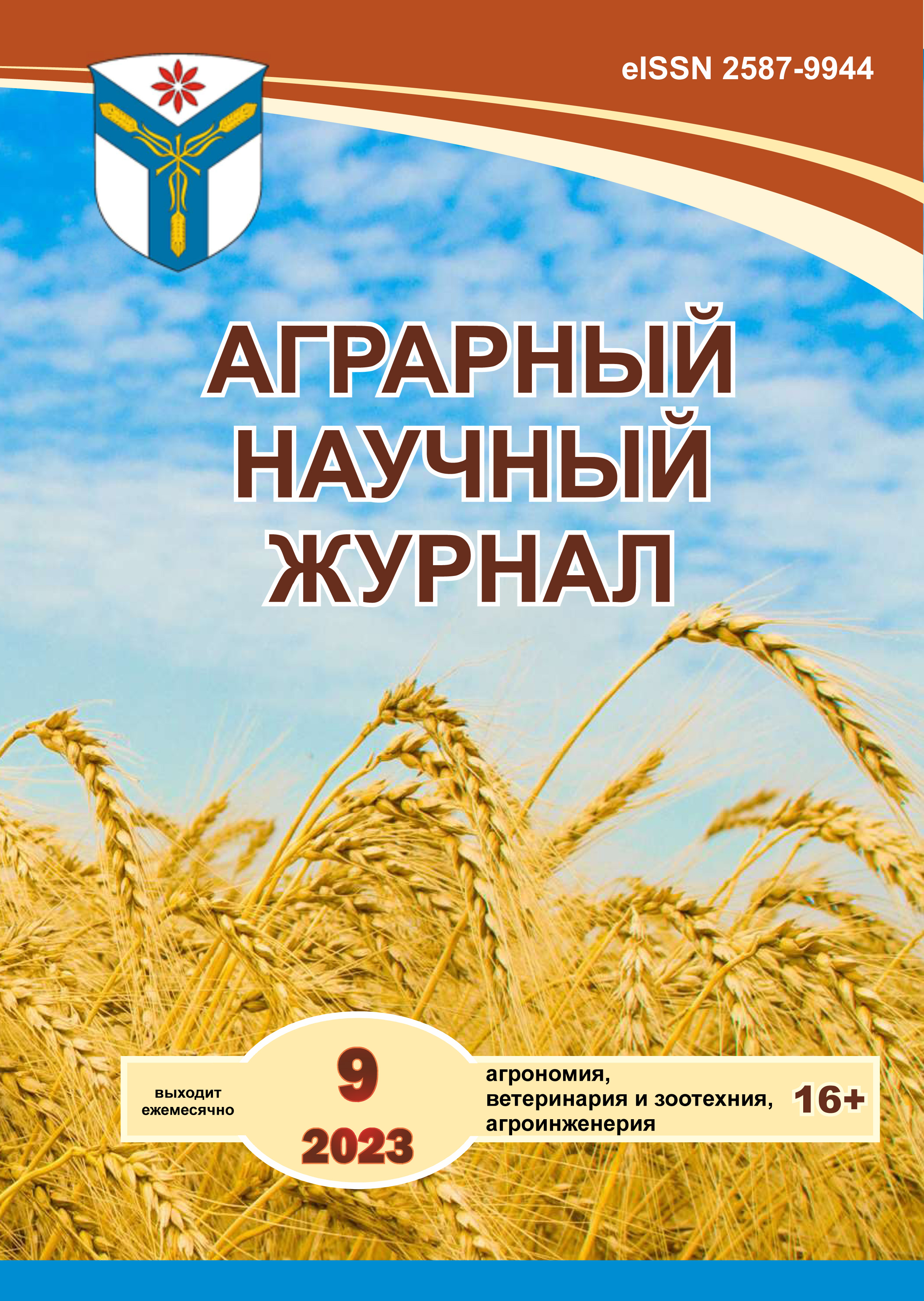The impact of abiotic and key environmental factors on barley yield
DOI:
https://doi.org/10.28983/asj.y2023i9pp15-21Keywords:
barley, air temperature, precipitation, dry days, hydrothermal coefficient, soil moisture, yieldAbstract
The purpose of the study is to determine the influence of agrometeorological factors (temperature, precipitation, dry weather), soil moisture, agrofon nutrition and precursor on the yield of barley in crop rotations and permanent sowing. The research is carried out from 2017 to 2022 on southern chernozems in the central zone of the Orenburg region. The scheme of the experiment consists of six options for growing barley on a fertilized and natural agrofone of a stationary experimental site for multi-fields and monocultures, laid down in 1990. The following methods of research are used in the experiments: field, thermostatic-weight method and dispersion analysis. As a result of observations, the air temperature during the growing season of barley is 20.7 ° C, precipitation – 111-112 mm, dry days – 68. The hydrothermal coefficient is 0.5 units, which characterizes the growing season as medium dry. The level of spring soil moisture in the meter layer of soil is from 97.0 to 123.8 mm in all variants of the experiment. In the second variant of the experiment, an increase in the yield of barley is observed in the aftereffect of millet and on the fertilized agrophone is 1.65 t, on the natural one – 1.51 t / ha. The yield of barley of the other variants is in the range from 1.26 to 1.61 t/ha. There is an increase in grain from mineral fertilizers by 0.03-0.27 tons for all variants of sowing barley. The best effect of atmospheric precipitation, spring reserves of soil moisture, precursors, mineral fertilizers on the yield of barley in the aftereffect of millet, peas and durum wheat in crop rotations has been established. The reasons for the decrease in the yield of permanent sowing of barley have been identified. The results of the study are of crucial importance in the development of agriculture and the production of feed grain in the steppe zone of the Southern Urals.
Downloads
References
Дубачинская Н.Н., Тишков Н.И., Тишков Д.Н., Косилов А.В. Влияние агроэкологических факторов на продуктивность сортов зерновых яровых культур и эффективность их использования в семеноводстве степной зоны Предуралья // Труды Кубанского государственного аграрного университета. 2020. № 84. С. 147–153.
Лазарев В.И., Минченко Ж.Н., Дериглазова Г.М., Гаврилова Т.В. Эффективность возделывания яровых зерновых культур в различных видах полевых севооборотов в почвен-но-климатических условиях Курской области // Международный сельскохозяйственный журнал. 2020. № 5(377). С. 17–20.
Левакова О.В., Ерошенко Л.М., Ерошенко А.Н., Ромахин М.М., Ерошенко Н.А., Дедушев И.А., Болдырев М.А. Оценка зерновой продуктивности и адаптивности отечественных и зарубежных сортов ярового ячменя в условиях Нечернозёмной зоны РФ // Аграрный научный журнал. 2021. № 3. С. 30–33.
Максютов Н.А., Зоров А.А., Скороходов В.Ю., Митрофанов Д.В. Влияние погод-ных условий на урожайность полевых культур в степной зоне Оренбуржья // Известия Са-марской государственной сельскохозяйственной академии. 2020. Т. 5. № 4. С. 8–17.
Митрофанов Д.В. Влияние ключевых факторов и почвенных процессов на продук-тивность ячменя в севооборотах на чернозёмах Предуралья // Вестник Ульяновской государ-ственной сельскохозяйственной академии. 2022. №1(57). С. 46–53.
Наумова Н.А. Особенности формирования зерновой продуктивности и её элементов у сортов ярового ячменя в условиях Астраханской области // Аграрный научный журнал. 2021. № 5. С. 29–34.
Скороходов В.Ю. Урожайность ячменя в шестипольных севооборотах на чернозё-мах южных степной зоны Южного Урала // Известия Оренбургского государственного аг-рарного университета. 2019. № 5(79). С. 93–97.
Солодовников А.П., Линьков А.С., Преймак С.А., Фисунов Н.В. Агрофизические, водно-физические факторы и погодные условия, определяющие урожайность зерна ячменя на темно-каштановой почве Заволжья // Аграрный научный журнал. 2022. №8. С. 29–32.
Borrego-Benjumea A., Carter A., Glenn A.J. and Badea A. Impact of excess moisture due to precipitation on barley grain yield in the Canadian Prairies // Can. J. of Plant Sci. 2018. No.99. P. 93–96.
Tadesse K., Habte D., Admasu W., Admasu A., Abdulkadir B., Tadesse A., Mekonnen A. and Debebe A. Effects of preceding crops and nitrogen fertilizer on the productivity and quality of malting barley in tropical environment // Heliyon. 2021. vol. 7. No.5. P. e07093.
Downloads
Published
Issue
Section
License
Copyright (c) 2023 The Agrarian Scientific Journal

This work is licensed under a Creative Commons Attribution-NonCommercial-NoDerivatives 4.0 International License.








